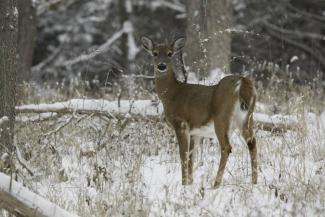Carrying Capacity: How many deer can your land support?
Known as the carrying capacity, the ideal density of deer on a landscape depends on what criteria are most important in a given situation. These criteria may be ecological, biological, or social.
Ecological carrying capacity: The number of deer the land can handle before deer cause habitat quality to decline.
Biological carrying capacity: The number of deer the land can hold before starvation and disease become a problem.
Social carrying capacity: The number of deer the landscape can hold before people start to view them as a pest.
In urban areas, you will need to consider the social carrying capacity. Tolerances for deer vary widely from person to person, so the social carrying capacity is difficult to determine but is often between 10 and 40 deer/sq. mi. The number of deer-vehicle collisions and extent of deer-caused damage to landscape will be a factor in determining this.
Deer Population Surveys and Monitoring
For many communities, monitoring population trends may be enough to assess management needs and effectiveness. More precise population surveys may be needed if your community chooses to reduce deer numbers quickly. To compare survey results over time, you should select a single method and use it consistently.
These methods each have advantages and limitations. Not all are suitable for residential areas.
Roadside Spotlight Counts:
Deer are counted at night using spotlights from a vehicle. Conduct these counts when leaves are off trees.
Pros:
- Low cost
- No special training required
- No statistical analysis conducted on data
Cons:
- Gathers trend information only
- Cannot be used to estimate population density
Distance Sampling:
This method is similar to roadside spotlight counts but additional data is collected, including sex and age class of deer, and distance from the road to the sighted deer. Data is then analyzed with statistical software (Distance) to estimate population density. Data must be collected when leaves are off trees.
Pros:
- Low cost
- Needs minimal equipment
- Can be used for population density estimates
- Can be easily applied in residential areas
Cons:
- Requires a minimum of three survey nights to produce strong data for analysis
- Requires trained observers and knowledge of statistical software for data analysis
Fecal Pellet Counts:
Surveyors count fecal pellets while walking survey lines.
Pros:
- Low cost
- Requires minimal training for data collection
Cons:
- Cannot be used to estimate population density
- Is used to collect trend information on populations and seasonal habitat use
Aerial Counts Over Snow Using Helicopter:
Deer are counted by observers in low-flying manned aircraft, most often helicopters. Six inches of snow cover is needed.
Pros:
- High detection rates
- Can be used to estimate population density
Cons:
- High cost
- Requires trained observers
- Can be used only when adequate snow cover exists
- Not all communities will allow low-flying aircraft over residential areas
Aerial Counts Over Snow Using Unmanned Aircraft:
Deer are counted via high resolution photography or video taken by unmanned aircraft over snow.
Pros:
- Increasingly accessible technology
- May yield higher detection rates than traditional live counts in manned aircraft
- May be better suited for residential areas than manned aircraft
- Can be used to estimate population density
Cons:
- This new technology comes with many unknowns, including detection rates and confusion over FAA restrictions for flight paths and altitude.
Thermal Imagery Counts:
Deer are counted with infrared cameras mounted on manned or unmanned aircraft.
Pros:
- Thermal imagery with other photo or video technologies may increase detection rates and survey precision.
Cons:
- High cost
- When used alone, detection rates are highly variable and can lead to unreliable population estimates.
Game Camera Surveys:
Motion-sensing cameras count deer at bait locations.
Pros:
- Low cost
- Requires little time in the field
- Can be used to estimate population density
Cons:
- Requires extensive time to sort and analyze photos
- Requires trained observers for photo analysis
- Some areas may not allow baiting at monitoring sites






















